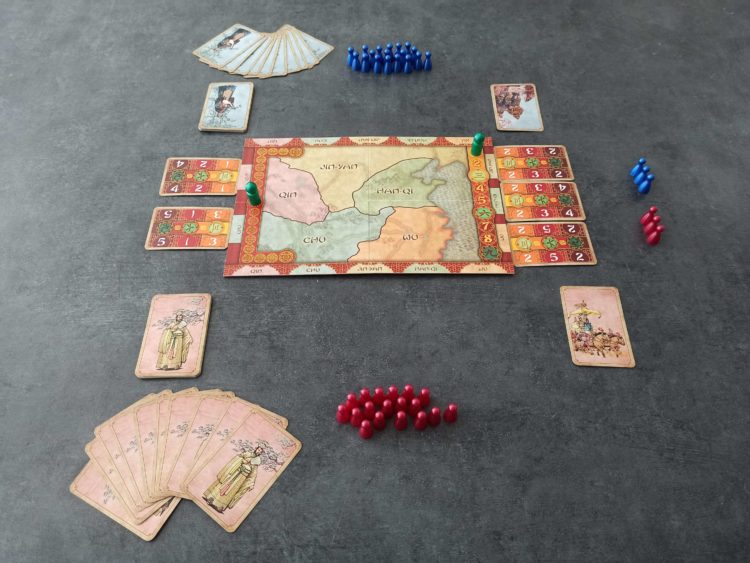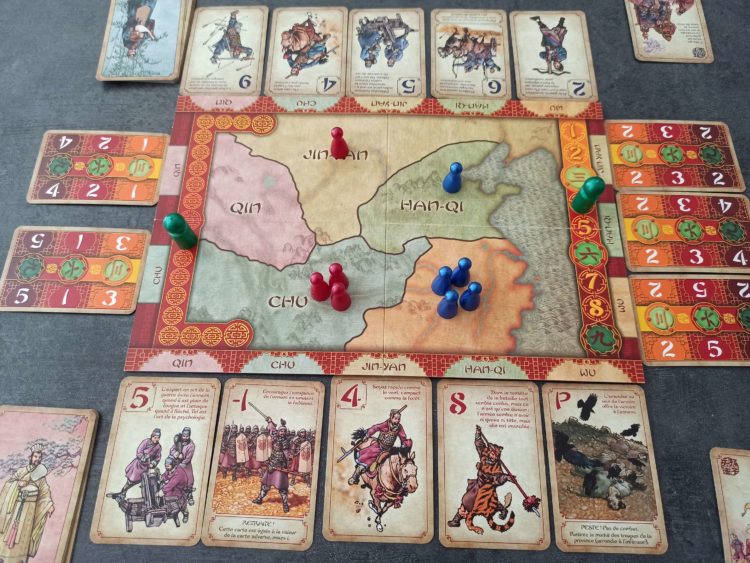
OBJECTIVE OF SUN TZU: The objective of Sun Tzu is to win the war by scoring the most points while conquering regions of ancient China.
NUMBER OF PLAYERS: 2
MATERIALS:
- 1 game board
- 42 Army pawns (21 of each colour, red and blue)
- 2 green markers (score and turn)
- 40 Action cards (20 of each colour)
- 6 Strategy cards (3 of each colour)
- 10 Score cards
TYPE OF GAME: Stratego Risk blend
AUDIENCE: teen, adult
OVERVIEW OF SUN TZU
Each player plays a Chinese general trying to conquer more territory than his opponents. By skilfully dividing their troops into the five regions each turn, players earn victory points. The goal is to reach 9 points at the end of the 3rd or 6th turn, or to have the most points at the end of the 9th turn.
SETUP
Place the game board in the centre of the table.
Draw 5 Score cards at random, and place each one face up next to the name of a province on the short sides of the board. Put the other Score cards back in the box.
Place one green marker on the first square of the turn track, and the other marker on the middle square of the score track.
Then each player:
- takes 18 armies of his colour (his reserve), and the 3 remaining armies are left out.
- choose 3 Strategy cards of his colour, taking care not to reveal it (the other two are put back in the box).
- takes in hand the 6 Action cards of his suit numbered 1 to 6.
- shuffles the other 14 Action cards of his colour to make up his draw pile.
- draw 4 cards from his deck, to have 10 cards in his hand.

GAMEPLAY
The game consists of 3 sets of 3 turns each. Each turn consists of 5 phases:
- Moving the turn marker
- Preparing actions
- Revealing actions and resolving battles
- Scoring
- Drawing
1 – Moving the turn marker
Move the turn marker one square at the start of each turn.
2 – Preparing actions
Each player chooses an Action card and places it face down in front of each of the 5 province names on their side of the board.
3 – Revealing actions and resolving battles
At this crucial stage, the cards are revealed and compared (see battle resolution).
Order of Battle Resolution: On the first turn of the game, reveal the cards starting with Qin and following the order of the locations, up to Wu. For the following turns, the player with the fewest armies on the board at the beginning of Phase 3 decides the order in which the cards are revealed. In the event of a tie, the last player to have had this privilege retains it. If no one has had this privilege yet, players continue to use the order of the first round until someone wins the privilege.
Fighting resolution:
For each province, the cards played by each player are compared. The card with the highest value wins the battle. The difference between the two cards represents the evolution of forces between the players:
- the player who has won the battle must place as many armies in the province as indicated by the battle’s outcome
- if he does not have enough armies in his reserve, the player must bring armies from one or more of his other provinces, starting with neighbouring provinces
When a player places armies after a battle in a province occupied by enemy armies, the armies eliminate each other: remove as many enemy armies as the number of placed armies. The remaining armies from either one or the other player remain in the province and thus grant control of the province to their owner. Armies eliminated after a fight return to the player’s reserve.

In this example, according to the armies already present and on the revealed cards, the following changes happen:
- the Blue player takes Qin, with 4 armies
- the Red player keeps Chu, but loses one army there
- Jin-Yan becomes neutral, the red player losing his army there
- the Red player takes Han-Qi with one army
- the Blue player keeps Wu, but loses two armies there from the plague
Special cards
Some Action cards have a special effect instead of (or in addition to) a numerical value:
- Card 1: a player using this card draws 3 cards instead of 2 at the end of the round.
- Card 6: a player using this card must place an army pawn on the small square next to the name of the province that has been dealt this card, on his side of the board.
- Cards +: the value of these cards is equal to the value of the opponent’s card plus the value indicated on the card (special case: +2 and +3 cards require the player to definitively sacrifice one and two armies respectively)
- Cards: the value of these cards is equal to the opponent’s card minus the value indicated on the card.
- Plague cards: instead of a battle, a plague epidemic breaks out, killing half of the troops present in the province, rounded down (the opposing card is cancelled).
Exceptional reinforcement
At the start of the game, each player has 3 armies left, to which can be added other armies removed from the game with the +2 and +3 Action cards. A player may return any of these armies to his reserve at any time, by permanently discarding from his hand an Action card other than Action cards 1 to 6. He must also show the discarded card to his opponent.
4 – Scoring (rounds 3, 6 and 9)
A countdown takes place at the end of each set, i.e. at the end of the 3rd, 6th and 9th rounds. Each Score card displays 3 values, corresponding to the points granted by the province at the end of each of the three sets. A player occupying a province with one or more armies at the end of a set scores the corresponding points. When scoring, players calculate the difference in points between them, and move the score marker for this difference in the direction of the player with the most points. For example, if the Red player scores 3 (2+1) and the Blue player scores 6 (3+2+1), the difference is 3 in favour of the Blue player, who then moves the score marker 3 squares towards him on the score track.
5 – Drawing
Each player takes back in hand the cards of value 1 to 6 (value surrounded by a frame) played during the round, and removes from the deck the other cards played during the round. Then each player takes the two cards from the top of his or her deck, looks at them, puts one in his hand and places the other under his deck. If he only draws one card, he keeps it.
Strategy cards
The strategy card chosen by each player at the beginning of the game can be played at any time, unless otherwise specified.
END OF GAME
At the end of the 3rd and 6th round of the game, if a player reaches 9 points (the large square at each end of the scoring track), he wins the game. Otherwise, the player with the most points, i.e. with the score marker on his side of the score track, wins the game. In case of a tie, the player with the most armies in his reserve wins.

Enjoy! 😊
VARIATIONS
Beginner mode
For a simpler first game,
- remove the +2, +3 Action cards and the 6 Strategy cards from the game
- each player starts the game with 21 armies
- Comprehensive Guide to the Board Game Go (weiqi, baduk) - January 23, 2024
- Are Creative Suites Changing Gaming - October 30, 2023
- Crowning the Kings of Solitaire: GameRules Recognizes Solitaired and MobilityWare as top Solitaire Games - October 20, 2023